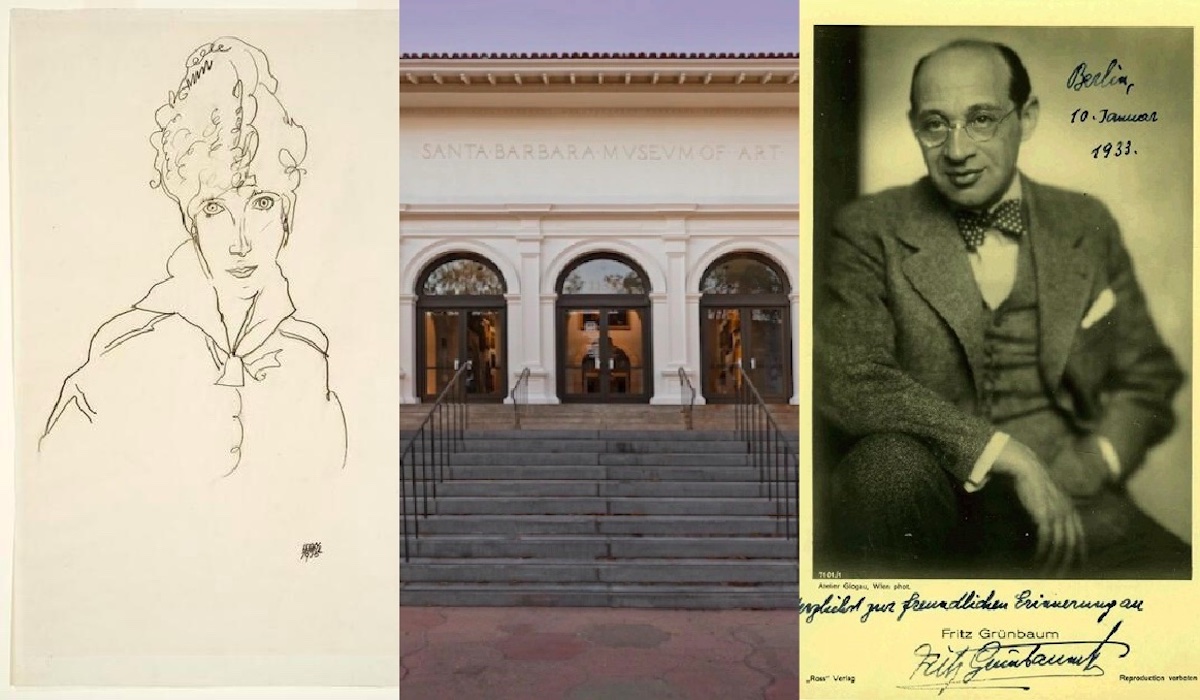Santa Barbara Museum of Art Sued over Nazi-Looted Drawing
Heirs of Jewish Cabaret Singer Killed in Concentration Camp Demand Return of Valuable Piece

The heirs of a Jewish cabaret singer and art collector killed during World War II have sued the Santa Barbara Museum of Art over possession of a prized drawing they say was robbed from their late relative by Hitler’s Third Reich.
“The Nazi regime stole the artwork from [Fritz] Grünbaum while he was in the Dachau Concentration Camp, where the Nazis tortured him and compelled him to sign an unlawful power of attorney giving his wife authority to convey his property, before murdering him,” the lawsuit states. Grünbaum’s wife, Elisabeth, was then forced to liquidate her husband’s assets before she herself was imprisoned and killed.
The heirs ― Timothy Reif, a judge on the United States Court of International Trade, and David Frankel, a financial services expert ― are seeking to reclaim the 1915 pencil on paper drawing “Portrait of the Artist’s Wife” by Egon Schiele. Records show the Nazis obtained it in 1939, and while its whereabouts were unknown for many years after that, it resurfaced at a New York gallery in 1956 and remained there until 1966. The Santa Barbara Museum of Art’s website states the piece was a gift from one of its founding members, Wright S. Ludington.
In their complaint, Reif and Frankel note how, following World War II, the U.S. State Department urged museums, universities, and art dealers to be vigilant against acquiring Nazi-looted artwork and to use extra caution around European pieces lacking complete provenances. The museum was specifically put on notice that the drawing might be stolen but “failed to exercise appropriate diligence in acquiring the Artwork or to make reasonable efforts to ascertain the true owners of the Artwork prior to taking possession,” the suit alleges.
The complaint also includes a previous ruling by a panel of judges in a similar case involving Nazi-stolen art. The panel balked at the suggestion by attorneys for a London-based art dealer that Grünbaum’s 449-piece collection had been given up legally and willingly. “We reject the notion that a person who signs a power of attorney in a death camp can be said to have executed the document voluntarily,” the judges wrote.
Museum spokesperson Katrina Carl said she could not comment on the pending litigation but noted the 18-inch-by-12-inch drawing “has not been on view for decades.” Reif and Frankel also recently filed suit against the Museum of Modern Art in New York over another piece by Schiele, a painting called “Prostitute.”
Since 2015, Reif has filed at least four other complaints that attempt to reclaim Grünbaum’s lost artworks. In 2019, a New York appellate court upheld a ruling that returned two more pieces by Schiele to the heirs. Grünbaum is believed to have owned at least 80 works by the Austrian expressionist. Those paintings ― “Woman in a Black Pinafore” (1911) and “Woman Hiding Her Face” (1912) ― were sold last November at Christie’s for $504,000 and $2,580,000, respectively.
Reif told reporters at the time that the proceeds would be donated to a foundation established in Grünbaum’s memory that supports underrepresented performing artists. “[Grünbaum] made loans to stagehands and musicians in his orchestra,” he said. “He was generous. That is a legacy we want to share.”
Until fairly recently, lawsuits like Rief’s often failed in court due to the statute of limitations over such legal actions. That is, until the federal Holocaust Expropriated Recovery Act was enacted by Congress in 2016, which eased requirements for the recovery of artwork that was lost or stolen through Nazi persecution.
Born in 1880, Grünbaum was a well-known Viennese entertainer who wrote and performed cabarets, songs, and operettas. He also directed and acted in films. While at Dachau, he often put on shows for his fellow prisoners, giving one last performance on New Year’s Eve, 1941, two weeks before he was killed.
Support the Santa Barbara Independent through a long-term or a single contribution.



